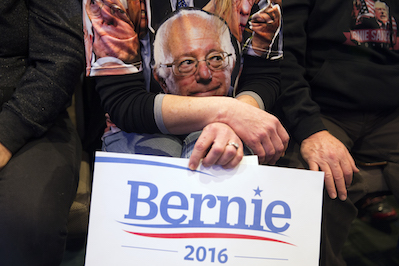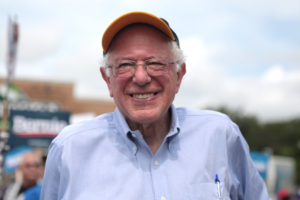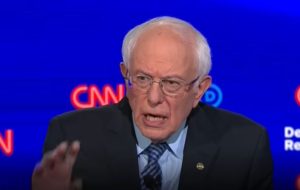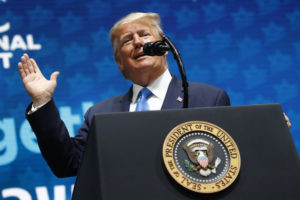Why Bernie Sanders Should Stay in the Race — and How He Can Win
By joining forces with the Green Party's Jill Stein, the Vermont senator would pose a formidable independent challenge to both Donald Trump and Hillary Clinton, two of the major parties' most unpopular candidates in recent history. A Bernie Sanders supporter holds a sign at a campaign rally. (Evan Vucci / AP)
1
2
3
A Bernie Sanders supporter holds a sign at a campaign rally. (Evan Vucci / AP)
1
2
3
The influence of Wall Street on candidates is also near the top of voters’ minds, with 84 percent of likely 2016 voters saying that they are concerned and 64 percent indicating that they are very concerned. Majorities across party lines say they would be less likely to vote for a candidate or member of Congress who received large sums of campaign money from big banks and financial companies, and 72 percent of Democrats, 54 percent of independents and 52 percent of Republicans say they would be more likely to vote for a candidate who favored tough rules on Wall Street to prevent irresponsible practices and abuses.
It is hard to imagine a better political climate for a Sanders-Stein general election campaign.
SUPPORT TRUTHDIG
Sanders Would Be Running Against Unpopular Candidates From Divided Parties
Sanders, if he stays in the race, would be running against the two most disliked major-party nominees in history. Donald Trump is viewed favorably by just 24 percent of the voters and unfavorably by 57 percent, making him by far the least-liked major-party front-runner since CBS began tracking such ratings in 1984. Hillary Clinton is viewed favorably by 31 percent and unfavorably by 52 percent. Sanders’ results are the opposite: His 48 percent favorability rating is by far the highest ever recorded. In the previous eight presidential cycles, there has never been a poll showing both major-party candidates with negative net-favorability ratings, let alone double-digit ones. On top of that, Sanders would be running against two divided parties. The last two Republican presidents and the last two Republican presidential nominees have said they will not even attend the Republican National Convention, and House Speaker Paul Ryan has said he is not ready to support Trump. The Hill newspaper has published a list of the top 99 Republican leaders who do not support Trump, and a CNN/ORC poll shows that one-third of Republicans would be dissatisfied or upset if Trump becomes the nominee. Trump recognizes these deep divisions and is telling the media he does not need a united party. Even the Koch brothers are saying that they prefer Clinton to Trump, and Clinton is embracing this development. The New York Times has reported that “Clinton’s campaign is repositioning itself, after a year of emphasizing liberal positions and focusing largely on minority voters” and is making “a striking turn … hoping to gain the support of Republican voters and party leaders including former elected officials and retired generals disillusioned by their party’s standard-bearer.” If Sanders endorses Clinton, she will have cover to move further to the right. According to the Times, Clinton is “confident that the young people and liberals backing Senator Bernie Sanders of Vermont will come around” to support her in November. But the reality is that the primary season has revealed a great divide within the Democratic Party. A McClatchy-Marist poll found that 25 percent of Sanders supporters will not vote for Clinton, and a Wall Street Journal poll found that 33 percent of Sanders supporters will not vote for Clinton. Many Sanders supporters describe her as Sanders’ opposite: He opposes Wall Street, and she is a Wall Street Democrat.A Trump Victory May Be More Likely Without Sanders
The big fear is that a run by Sanders would result in a Republican victory for Donald Trump. People always hark back to the Gore-Bush-Nader race of 2000, but that is the mistake of fighting the last war and not the current one. (It is also a myth that Nader cost Gore the election.) Things have changed drastically in the 16 years since then. The risk of a Trump victory may actually increase if Sanders does not run. In the Nader era, independents and the two parties almost equally divided the electorate. Now the two parties are below 30 percent (the Republicans at 21 percent), and independents are over 43 percent. Not only do fewer voters consider themselves Republicans or Democrats, but even many of those who do are not enthusiastic about their party or their likely nominees. An NBC News/Wall Street Journal survey found 7 percent of Sanders voters could see themselves supporting Trump. These Sanders supporters share a strong dislike of Hillary Clinton and see both Trump and Sanders as outsiders who understand their economic hardship. Trump is now pursuing Sanders voters. According to AlterNet’s Steven Rosenfeld, Trump has “recited Sanders’ critique of trade deals, the Iraq war, Clinton’s Goldman-Sachs speeches, and even slammed Medicare prescription drug price gouging as he paints himself on the side of frustrated Americans.” “As he said on the eve of Indiana’s primary,” Rosenfeld continued. ” ‘I think a lot of the Bernie Sanders young people are going to join my campaign.’ ” Trump may be right. “Forty-four percent of Sanders supporters surveyed said they would rather back the presumptive GOP nominee in November,” an exit poll after the West Virginia primary found, “with only 23 percent saying they’d support Democratic front-runner Hillary Clinton.” Moreover, “31 percent … would support neither candidate in the likely general election match-up.” Without Sanders in the picture, Trump could run to Clinton’s left, broadening his support base and capitalizing on Clinton’s weaknesses. On Wall Street corruption, Trump will be able to say that he did not take funds from Wall Street while Clinton has. Trump has proposed taxing Wall Street, whereas Clinton protects the investment class. Trump has come out for raising the minimum wage while Clinton has been slow and hesitant to support raising it to $15 an hour. Sanders has already taken these popular positions, making it harder for Trump to benefit from them if Sanders were in the race. Even on the issue of militarism, where Clinton is weak, Trump has made some sensible statements against wars that contrast with Clinton’s militarist positions. Sanders has run to her left on Iraq, Libya, Syria and Israel, as well as on regime change and military engagement. Jill Stein would bring an even stronger view against intervention and militarism, leaving little room for Trump to take advantage of Hillary’s penchant for war, militarism and intervention. The dynamic of the race would also be different if Sanders is running. Both Sanders and Clinton would have a common opponent in Trump, and each would echo the other’s criticism of him. Together, they could prevent Trump from growing his base of support.Sanders-Stein Could Win 270 Electoral Votes
In April, after the New York primary results came in, Sanders described his winning coalition: “The reason we are doing so much better against Republican candidates is that not only are we winning … Democratic votes, but we are winning independent votes and some Republican votes as well. That is a point I hope the delegates to the Democratic convention fully understand. In a general election, everyone — Democratic, independent and Republican — has the right to vote for president. The elections are not closed primaries.” Sanders has defeated Trump by more than 14 points in the last 10 polls measuring who would win if they ran against each other. And Sanders and Clinton are neck and neck in national polls. Sanders, the most popular politician in the country, does best among independents and youth and is the strongest general election candidate. Positive or negative ratings often determine the outcome of the election. Sanders is the only candidate who is generally viewed positively. “Overall, a clear portrait of Sanders emerges that is different from those of the other candidates,” Gallup reported. “He has a generally positive image, wins on the ‘softer’ dimensions of leadership and is above all else seen as caring, enthusiastic and consistent.” Further, Sanders “does well across all the [leadership] dimensions, with a more even distribution of perceived leadership characteristics than is the case for the other candidates.” In comparison, The Wall Street Journal found that 56 percent of both Trump and Clinton voters said they would cast their vote simply because they didn’t want the other candidate to win. Sanders does better among independents, the new plurality that will decide the election, than Clinton or Trump. In the primaries, he beat Clinton among independents by 29 percent. She has done poorly with independent voters in the primaries thus far and has been unable to win the independent vote in any state other than Alabama. Your support matters…Independent journalism is under threat and overshadowed by heavily funded mainstream media.
You can help level the playing field. Become a member.
Your tax-deductible contribution keeps us digging beneath the headlines to give you thought-provoking, investigative reporting and analysis that unearths what's really happening- without compromise.
Give today to support our courageous, independent journalists.






You need to be a supporter to comment.
There are currently no responses to this article.
Be the first to respond.